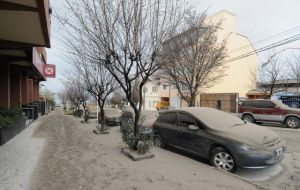MercoPress. South Atlantic News Agency
Google Earth will tell the world that Patagonia is coming out of the ashes
 Bariloche was one of the resorts worst hit by the consequences of the ashes
Bariloche was one of the resorts worst hit by the consequences of the ashes Ash-victims in Argentina from the Chilean Puyehue volcano eruption are mounting a huge sign to the picked up by the Earth Google satellite inviting world tourists to return to Patagonia. The project should be finished in coming weeks and is promoted by the NGO Solidarity Network Argentina.
“The contour of the sign is ready and in a couple of weeks we should have ‘filled’ it with substance”, said Juan Carr head of the NGO.
With the reading “ElijamosPatagonia.com” (Let’s choose Patagonia) the sign which will be sighted by Google Earth is three kilometres long, 100 metres high and the writing has been displayed with 125.000 recycled plastic bottles, recalling the eruption of June last year which covered vast areas mainly of Argentina because of the prevailing winds.
“Google has confirmed it’s going to take special images of the sign. We want to attract attention from space and tell the world that tourism can return to the Patagonia region which lives off this activity and which was so punished by the ashes”, said Carr.
The sign is close to the summer and snow resort of Bariloche (1.600 kilometres south of Buenos Aires) and the website which refers to the event is already available and promotes the visit to different tourism destinations in Argentine Patagonia.
“It’s a community project”, according to Carr, and an estimated 180.000 people from Villa Angostura, Bariloche and San Martin de los Andes among other places which suffered the consequences of the volcanic eruption, have contributed to the enterprise.
The initiative to recycle bottles has gone far beyond the number needed for the sign and an estimated 590.000 have been recovered, “which is equivalent to the bottles that before where dumped in the area in just two weeks”, pointed out Carr.
The Puyehue volcano erupted for several weeks beginning June last year and the cloud of ashes not only covered areas of Chile and Argentina, endangering cattle, sheep and wildlife left with little to eat, but also interrupted for several days on occasions air traffic in the south of the continent.
Argentina’s main airports, as well as in Uruguay and in the south of Brazil had to be closed at times. The cloud even reached Australia and South Africa where it also caused inconveniences for air travel.
UN Secretary General Ban Ki-moon on a South American tour at the time had to land in Cordoba (north central Argentina) and reach Buenos Aires by car.
The resorts of Bariloche and Villa Angostura among the worst hit, were without any air activity for months thus ‘killing’ the winter season.
In Bariloche a report from the University of Rio Negro shows that an estimated 3.000 small businesses and shops suffered the impact of the ashes and only 25% of them have recovered.
In the province of Chubut with 1.5 million sheep it is estimated that 10% were lost because of lack of food or because the weight of the wool mingled with the ashes immobilized the ovine.
.




Top Comments
Disclaimer & comment rules-

-

-

Read all commentsArgentines appear to have included the Falkland Islands as part of their Patagonia region for promotion, although have misnamed it “Malvinas”. For Spanish-speaking South Americans, the Falkland Islands Tourism has some tips for getting to the Islands and spending a nice holiday: http://www.falklandislands.com/contents/view/412/lang:es
May 21st, 2012 - 04:23 am 0The Beagle Islands Conflict
May 21st, 2012 - 01:16 pm 0After refusing to abide by binding international award giving the islands to Chile, the Argentine Junta pursued the controversy to the brink of war in 1978 in order to produce a maritime boundary consistent with Argentine claims. Even the Pope proposed a solution that was accepted by Chile but rejected by the Argentine government. So perhaps this is devine intervention...
Brit Bobo, perhaps your father and your mother are brothers, that could explain your thinking way.
May 21st, 2012 - 06:15 pm 0Commenting for this story is now closed.
If you have a Facebook account, become a fan and comment on our Facebook Page!